Zoom In On Your Target With These Expert-Recommended Spotting Scopes
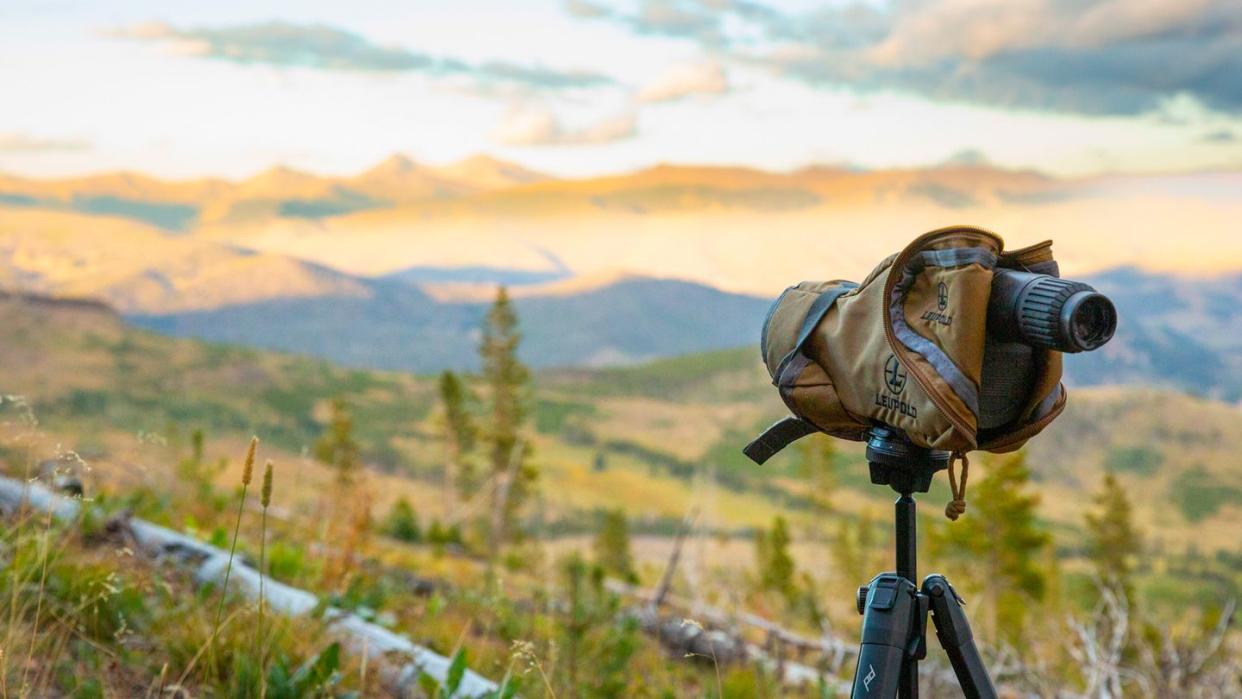
"Hearst Magazines and Yahoo may earn commission or revenue on some items through these links."
You certainly know about binoculars and telescopes for magnifying faraway objects. But consider their in-between sibling, spotting scopes. They’re the sweet spot of specialty optics, letting you zoom in on wildlife, stars, targets, birds, and more—so you can see in detail what your eyes can’t achieve on their own.
Whether you’re birding, hunting, shooting, or stargazing, spotting scopes cover a middle ground that falls between the relatively close distances covered by binoculars and the galactic expanses that telescopes traverse. While they’re not as easy to use as binoculars, a good spotting scope can show you details you might easily miss with the magnifications used in most binoculars.
For hunters, a spotting scope usually doesn’t replace binoculars but can be a great way to gain follow-up knowledge. When “glassing” terrain with binoculars, you may want more detail on a particular object or zone in your view. Pulling out a spotting scope at this juncture can, for example, help you determine if a bighorn sheep you spotted is of legal size.
If you’re shooting targets at ranges of 100 yards or more, it can be difficult to see your hits with binoculars. A steady tripod-mounted spotting scope gives you greater magnification view of the target to see your marks and avoid having to physically walk to the target after each shot.
And for birding and other wildlife watching, a spotting scope is a great way to get up-close, detailed views of your quarry if you’re not able to get close enough to get a satisfying view through binoculars. Stargazing is usually left to telescopes, but if you have other uses for a spotting scope and don’t want the extra expense of a telescope, a powerful spotter can be a fun tool for examining the night sky.
For any of the above-mentioned pursuits, a spotting scope can be a useful addition to your optics arsenal, even if binoculars are still your primary tool. Here are seven of my favorites at a variety of budgets, and how to pick the one that’s right for you.
Best Spotting Scopes
The Expert: I’ve been hunting with binoculars for more than 30 years, but my passion for quality optics really came into focus when I moved to Colorado in 2010 and started searching high and low for big game. I added a spotting scope to my toolkit about eight years ago, and while it doesn’t replace binoculars, my spotter comes out when I need to cover extra distance or pick up additional details. I’ve used spotting scopes not only for hunting and recreational wildlife spotting, but for assisting the local parks and wildlife team in counting animals for their annual population surveys.
What to Consider in a Spotting Scope
Magnification
Whether you pick a spotting scope or binoculars depends on what range you want. Most spotting scopes pick up where binoculars leave off and tend to fall somewhere in the 12 to 80 power-magnification range. They also almost always are “zooms,” meaning they offer a range of magnifications—say, 20- to 60x—rather than a fixed setting.
If you mostly need magnification below 15x, you’re better off with binoculars, which are easier to use and generally lighter and more portable, though they can be pricier for quality glass since the manufacturers have to fit the optics in a smaller, doubled package.
More Gear to Consider: Best Range Finders • Best Headlamps • Best Ladder Stands
While 10x42 (magnification power by objective lens diameter) has long been a standard binocular size, especially for hunters, higher magnifications around 15x are becoming more popular as are larger diameters around 50mm. If you aren’t sure if you need a spotting scope, consider using more powerful binoculars that may let you see a little farther without having to cart around an entirely separate piece of glass.
Objective Lens Diameter
Objective lens diameter is essentially the size of the viewing field you get out of your spotting scope. Lightweight backpacking spotting scopes might be as small as 40mm, while larger stargazing scopes will be around 100mm. Bigger is generally better because larger glass lets in more light, but that usually ups the cost and the weight of your spotting scope. Knowing how you intend to use the scope (and spending some time using scopes of different sizes, if you can) will help you figure out how to balance those factors to find the scope that’s right for you.
I personally find that any scopes smaller than about 50mm are too small a field to be worth using. Squinting one eye to try and clearly see something miles away is hard enough in oversize scopes; binoculars may be a better choice. If you’re buying a scope for mostly stationary use and don’t have to worry about weight, I recommend getting the largest diameter you can afford.
Weight
For some people—hunters who mostly use their spotting scope from a vehicle, or day hikers who carry basic supplies—weight is a minor concern. For others, it’s a major factor. If you’re hiking miles to a remote mountaintop to stargaze away from light pollution or climbing 14,000-foot peaks to hunt bighorn sheep, a lighter, smaller scope may be your best option.
So what’s “light''? Spotting scopes marketed as lighter-weight options are usually 3 pounds or less, while standard ones are around 5 pounds or more. Keep in mind that you’ll also need a tripod to stabilize your spotter, so count on an additional 3 to 5 pounds of pack weight. Even the lightweight carbon-fiber Vortex Ridgeview Tripod weighs 3 pounds, and most cheaper tripods will weigh 4 pounds or more.
Straight or Angled View?
Many models of spotting scopes come in two distinct versions: straight or angled. This refers to the eyepiece orientation. While you can learn to effectively use either proficiently, the way you use a spotting scope may suggest a preferred option.
Angled eyepieces are generally considered more comfortable to use. The angled eyepiece lets you move the eyepiece around and look down onto it without craning your neck, which is useful for stargazing. It also keeps your tripod lower and more stable. When shooting from a prone position, you can simply set the scope up to one side of where your rifle is, whether target shooting or long-range hunting.
Straight eyepieces are a bit more intuitive to use, although you’ll eventually get used to either. If you’ve spotted something in your binoculars and want to see more detail using your spotting scope, it’s a bit easier to aim the straight spotting scope and zero in on it. It also means you won’t have to move a tripod head to swap between binoculars (two straight eyepieces) and a straight eyepiece spotting scope.
Straight scopes also are better when looking downhill, since using an angled scope when looking downhill means rotating the eyepiece or trying to get above your scope at an unnatural angle. Hunters who use a car window mount to scan country from a vehicle generally prefer straight scopes since it’s easier to get your eye in the right position when seated and you have limited options for moving your body and the scope.
Price
At anywhere from several hundred to several thousand dollars, a spotting scope is a luxury item for most people. I have used scopes up and down the spectrum, and while it’s impossible for me to say for you if it is “worth it” to spend $3,000 on a spotting scope, I can tell you that it is probably not worth it to spend less than $100 on one. The lowest-tier scopes can be frustrating to use, and the image quality tends to deteriorate so badly at higher magnifications that you often aren’t getting what you bought a spotting scope for in the first place. Instead, we’ve included several mid-price picks here.
It’s hard to quantify what you get for your money with a spotting scope since, while there are lots of specs, it’s difficult to judge something as subjective as optical quality; there’s no universal quality standard for easy comparison. As well, you get increasingly marginal gains in quality as price goes up.
If your budget doesn’t allow you to spend at least a few hundred bucks, consider putting that money towards a higher-end pair of binoculars instead. This can often be enough for most hunters and wildlife spotters and will often perform as well or better (when used on a tripod) than a cheap spotting scope. They’re also easier on your eyes and intuitive to use.
How We Evaluated Spotting Scopes
My selections here are based on conversations with optics brand representatives, small shop owners, other hunters, and sales reps in big chain outdoors stores. I also have experience using spotting scopes in a variety of terrain in the Mountain West as a lifelong hunter who has chased elk around the Rocky Mountains for the past decade. I spend a lot of time at the shooting range, where I consider a spotting scope essential equipment beyond 50 yards. I tested scopes hands-on in the field and at optics dealers to compare performance side-by-side and in real-world conditions.
Viper HD 15-45x65mm
Optics from this family-owned American brand are ubiquitous in hunting because they offer quality performance at lower prices than most high-end brands.
While the Viper scope (and the whole Vortex line) is aimed at hunters, this is a high-performance scope at a mid-tier price. The compromise 65-millimeter objective lens size makes the scope small enough to be packable but big enough to be comfortable to use in the field or at the range. It weighs just over 3 pounds, which is about as light as you can hope for at this size and quality.
There are certainly better, more expensive scopes available (Vortex’s Razor line and plenty of other ultra-high-end options from brands), but for most buyers, the marginal improvements aren’t worth the hundreds, if not thousands, of extra dollars required.
Vortex is respected for its no-questions-asked VIP Warranty. While several other optics brands now offer similar guarantees, Vortex has decades of history of standing behind its warranties. The scope retails for just over $1,000 MSRP on the brand's site, but it can almost always be found online for much less.
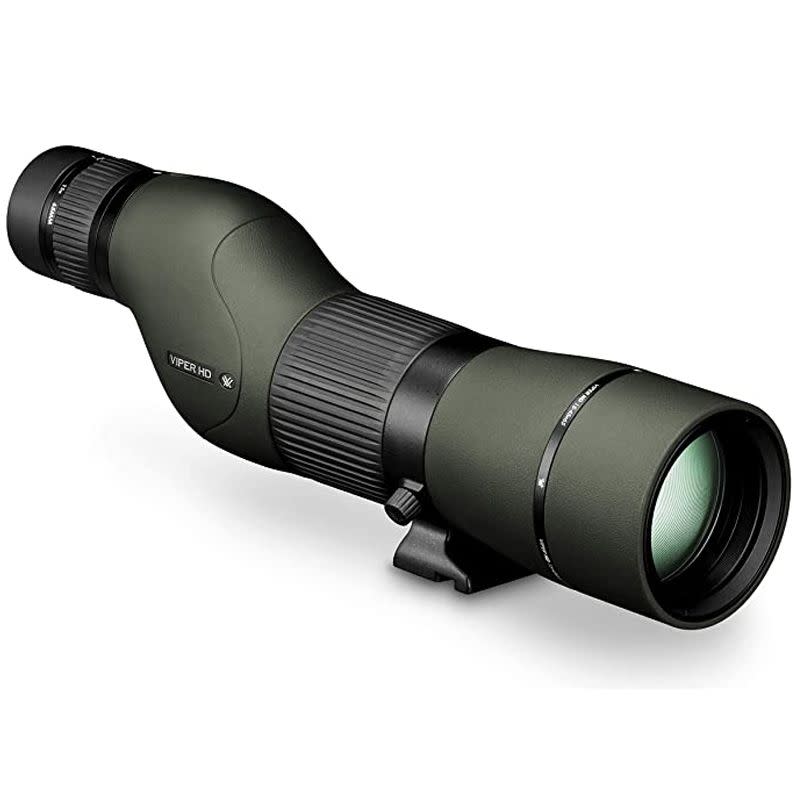
Viper HD 15-45x65mm
amazon.com
$699.00
Ultima 80 20–60x80mm Spotting Scope
If you’re going to go cheap, go big. While more expensive spotting scopes can improve light transmission with fancy coatings and prism technology, there’s no substitute for a bigger objective lens when it comes to bringing in more light.
The 80-millimeter objective lens on the Ultima from Celestron makes for a heavy scope, but it offers much of the function (if not quality) of mid-tier scopes at a fraction of the price.
While this is a budget option, Celestron is a California-based company well-known for its stargazing telescopes. And while it may not be on-par with the quality of more expensive glass, it shares most of the same tech and features.
This includes multi-coated lenses to maximize light, waterproofing, and even an integrated adapter to attach a camera for digi-scoping (placing the lens of a digital camera to the eyepiece of your spotting scope so you can take photos), if desired.
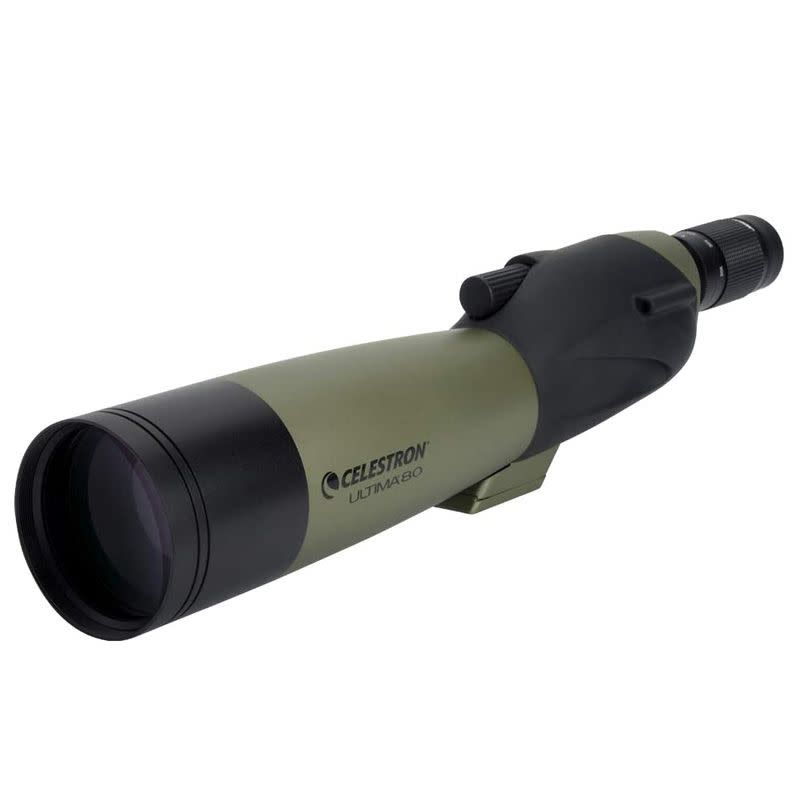
Ultima 80 20–60x80mm Spotting Scope
amazon.com
$229.00
BTX
Spotting scopes can be frustrating to use if you're accustomed to the relative comfort of binoculars. Squinting the non-dominant eye closed and hunching over a spotting scope gets tiring in minutes, whereas most can glass on and off with binoculars comfortably for an hour or two.
The Swarovski BTX System completely solves this problem by offering a binocular eyepiece for its high-quality spotting scope objective lenses. This beefy setup is pricey, no surprise, but with a headrest and dual eyepieces, you can have the binocular experience with the power of a spotting scope. I have tested this setup at my local dealer many times and it is a breath of fresh air compared side-by-side with a traditional spotting scope.
The downsides are fairly obvious: weight and price. At over 10 pounds, this is not a unit you're lugging very far from a vehicle, especially since you'll need a heavy-duty tripod to properly stabilize the heavier optic. The cost is also about as much money as you can spend on a spotter setup, so it's not realistic for most. Still, if I were to go all-in on an optic, I would strongly consider the BTX.
Though it costs a bit more than the top-of-the-line spotters from other high-end optics brands, it's not that much more and I would take the comfort of the dual-eyepiece build over any other high-end spotter, regardless of glass quality and other features.
If there's a performance downside here, it's that Swarovski had to employ a fixed focal length here to make the design work, so you're stuck at 30x (35x on larger objective lenses) and won't be able to twist to zoom in like on most spotters.
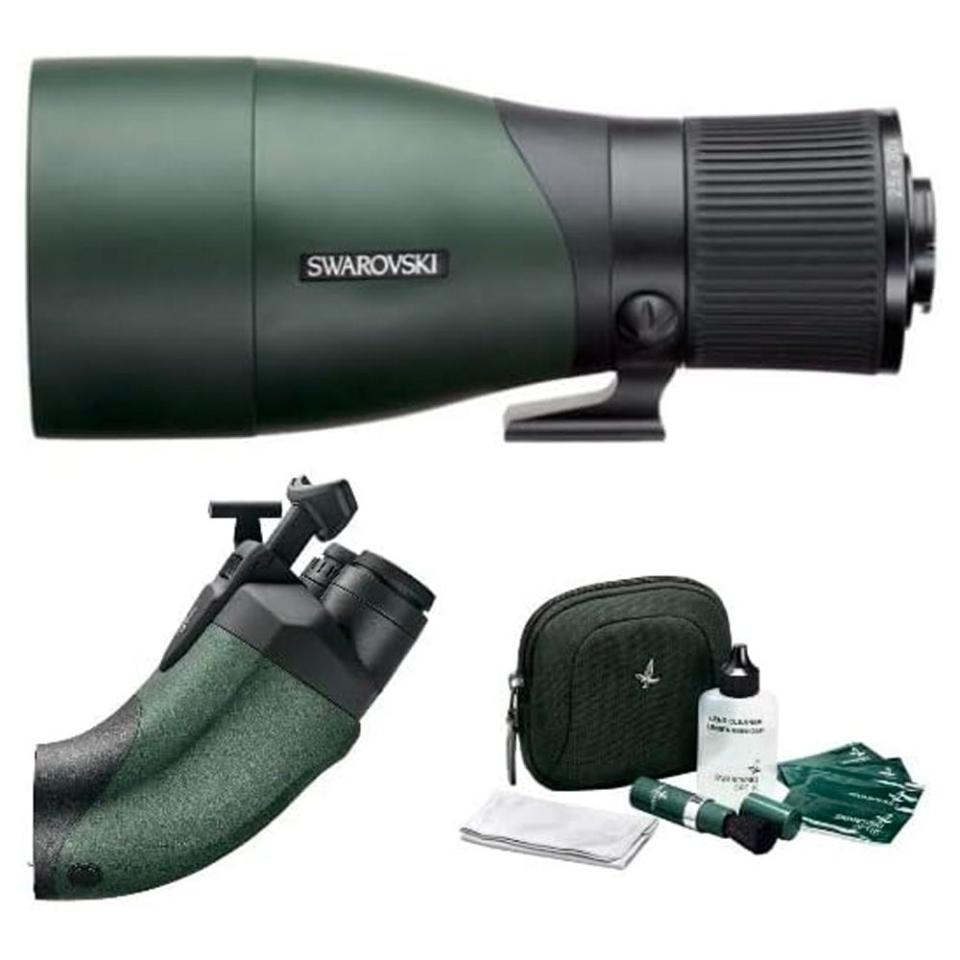
BTX
amazon.com
$4929.00
ProStaff 5 20–60x82mm
Hunters are as obsessive over their gear as photographers. For that reason, plenty of Nikon optics find favor with the hunting crowd, but that same quality serves recreational wildlife spotters just as well.
Nikon takes its pedigree for quality glass in camera lenses to the ProStaff series of spotting scopes to deliver sharp, high-contrast imagery with accurate color at a mid-range price point. The Monarch line offers higher-fidelity glass, but the same size spotter from the Monarch line costs more than double the ProStaff 5 for marginal gains in quality—a price many aren’t willing to pay.
Because of the oversized 82-millimeter objective lens, there’s plenty of light gathered here, even if it’s not Nikon’s highest-end model. It’s also fairly lightweight for toting in a backpack as far as you need to find the animals you’re looking for. It’s also built for the outdoors, with a waterproof and fog-proof build and sliding sunshade to minimize glare.
This model is also digiscope-ready if you want to add on the ability to capture the images you’re seeing through your spotter. The shortcomings of the mid-range glass become apparent at maximum magnification (like most spotting scopes), but the performance for the price will be more than enough for most birders and wildlife enthusiasts.
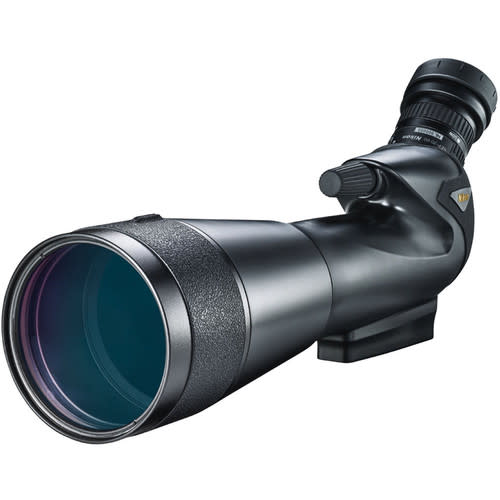
ProStaff 5 20–60x82mm
bhphotovideo.com
$546.95
GPOTAC45 15-45x60 Spotting Scope
Any good spotting scope is an essential tool for long-range shooting, but the GPOTAC45 spotting scope is purpose-built for the task.
A first-focal plane reticle means the reticle adjusts accurately to fill the viewing area as you zoom in and out. Like all GPO optics, you get German engineering, quality control, and excellent glass for a lower price than that of the high-end optics companies.
Where this optic really shines is with its long-range specific features, like a side-mounted Picatinny rail for add-ons such as a red-dot for faster target acquisition. The GPOTAC45 is at its best when paired with GPO’s GPOTAC 4.5-27X50i FFP Tactical riflescope, which employs the exact same reticle so you can seamlessly make shot adjustments when using both optics for setting up and tweaking your long-range shots.
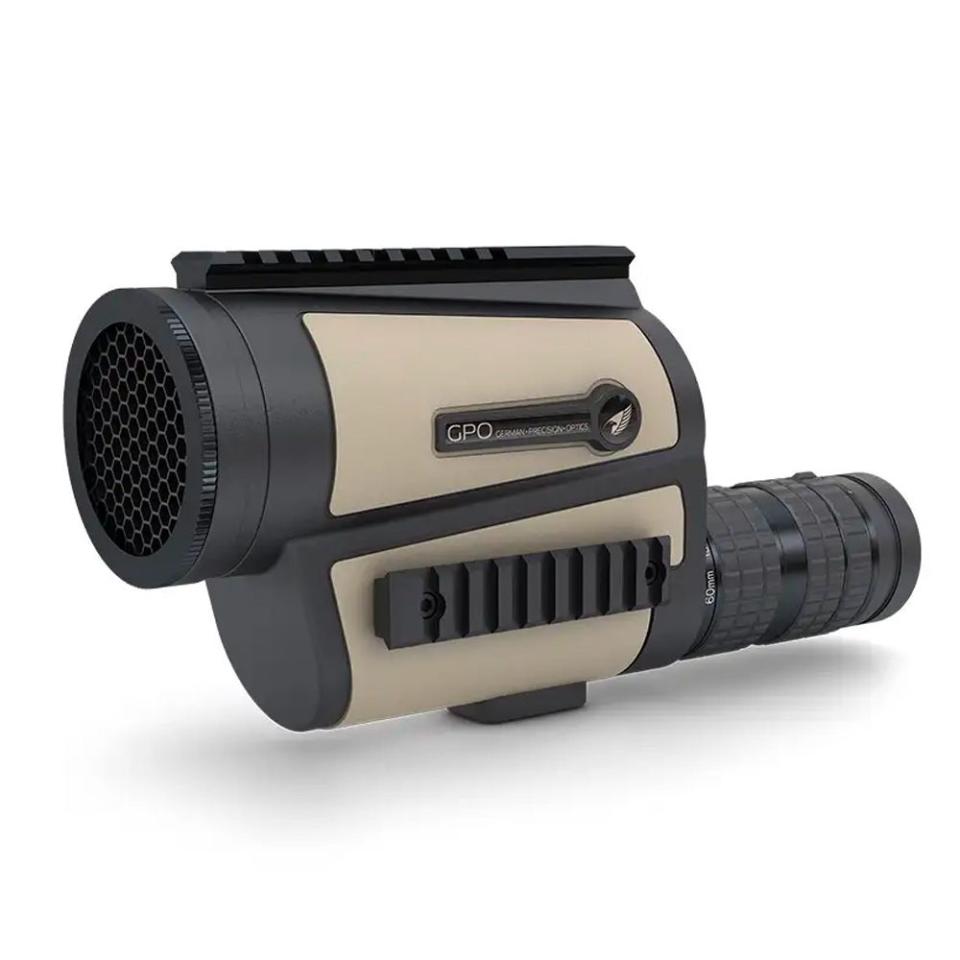
GPOTAC45 15-45x60 Spotting Scope
opticsplanet.com
$1299.99
CS.1A 15–45x65mm
The CS.1A from Wyoming-based Maven is lightweight without having so small a viewing field as to be frustrating to use (as many ultra-compact spotters are).
The 40-ounce CS.1A picks up right where binoculars leave off, with a broad magnification ranging from 15x to 45x. The angled design is a bit easier to get into position, especially if you're taller or have a shorter, compact tripod. But there is a straight version that's easier to slide into a pack if you're heading out for a hike.
Maven optics, in general, provide quality Japanese components at a relatively low cost, but the C series models offer slightly lower price points while still delivering quality glass. (You can spend a little extra to customize up to eight individual components of the scope with custom colors and camo patterns to create a personalized spotter.)
Like almost all spotting scopes, the image quality deteriorates a bit at the extreme end of the magnification, but it’s nice to have when you’re pushing to see important details at a distance.
The low-end 15x magnification is great for orienting yourself before zooming further in to pick apart details. This isn’t the lightest scope on the market, but it’s a weight that’s realistic to carry into the backcountry when you need it.
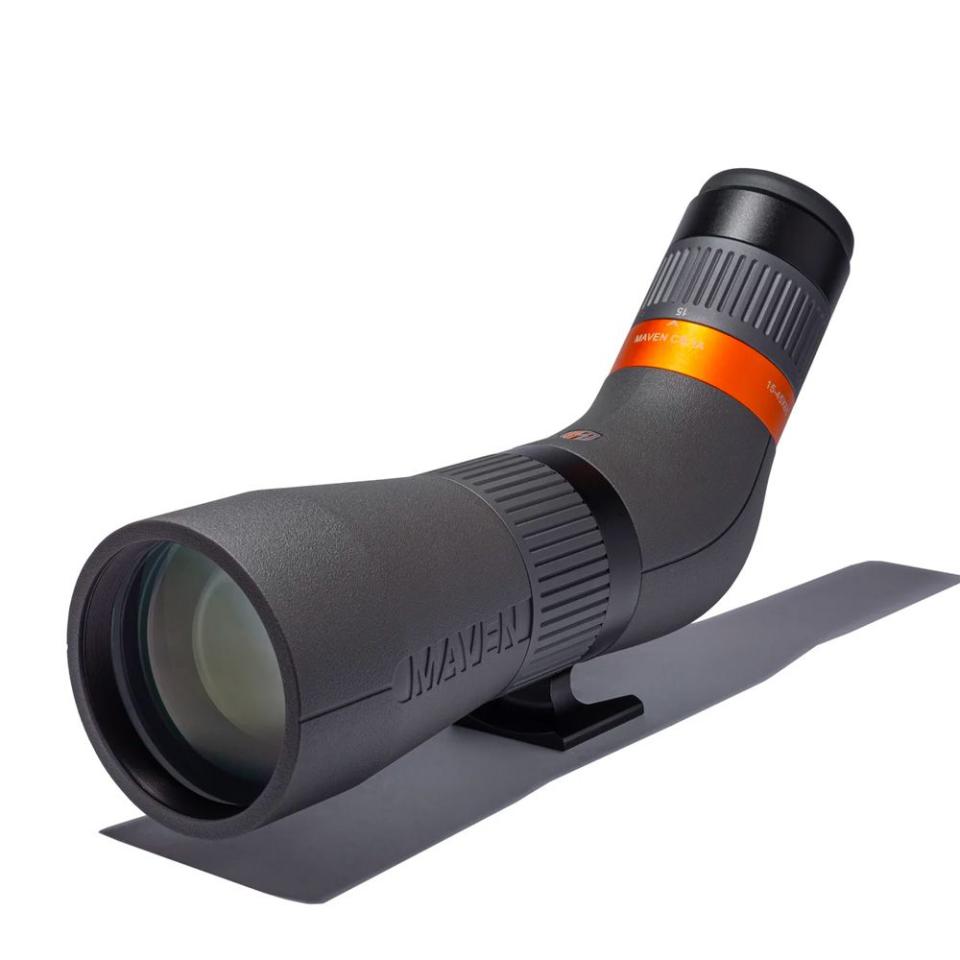
CS.1A 15–45x65mm
mavenbuilt.com
$800.00
Ultima 100 22–66x100mm
At about 4.5 pounds and with a 100mm diameter, this monster scope from Celestron isn’t ideal for carting around, but is a great option if you do most of your stargazing from home.
This is a relatively affordable option that gives you decent optical quality in a light-grabbing, 100mm objective lens. Thus also makes it easy to use with the wide field of vision. Image quality in the 22-66x zoom will deteriorate at maximum magnification like any scope in this price range, but the middle sweet spot is enough to enjoy astronomical details up close.
The angled eyepiece is a great choice for when you’re mostly looking up, but it is also easy to use generally, which makes this a valid option for the shooting range as well.
If you’re a serious astro-photographer, you’ll want to spend more to get improved optical quality or consider a proper telescope instead. But if you value a versatile spotter for wildlife, shooting, and other stationary spotting besides just stargazing, it’s a solid option.
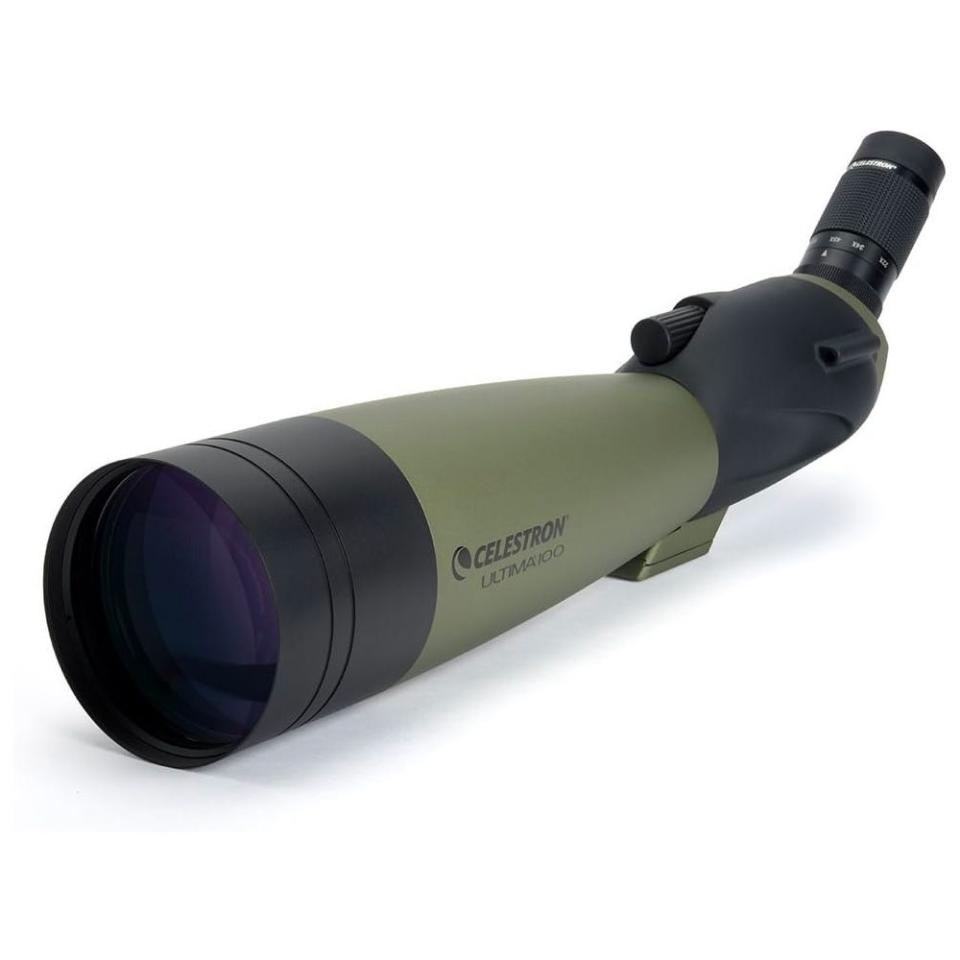
Ultima 100 22–66x100mm
amazon.com
$398.00
See Your Way To A New Scope With This Buying Advice From Our Expert, Justin Park.
For my first scope, do I want the eyepiece attached or not?
Some spotting scopes will come with detachable eyepieces while others have them fixed or permanently attached. For most buyers, it won’t matter if an eyepiece is detachable or not.
An advantage of a detachable eyepiece is that you could, if desired, swap in a different style or level of magnification eyepiece for the one that came with your product. However, I don’t recommend factoring this in too heavily in your purchase decision. It’s much more important to choose a spotting scope that fits your needs in the way that it’s set up from the manufacturer than to assume you can swap out the eyepiece if it’s not quite right for you.
This creates an additional cost and you’re likely better off just returning it for a different model that comes with the type of eyepiece you’ve decided you want.
In simple terms, what do I need to know about ED, HD, XD, and APO lenses?
All of these terms refer to lens technology that improves the image quality through the glass and/or treatments to the glass. The “D” in ED, HD and XD stands for dispersion, which is a blanket term for distortions that can occur in lower-quality glass due to the way light passes through the glass.
Unfortunately, these are not standardized terms, so all you can really assume from their use is that the scope you’re looking at addresses these distortions in some way. If you’re comparing scopes in one particular brand’s lineup, the terms may shed some light on which scopes offer better quality glass than others, but these marketing labels aren’t useful for deciding which scope is better between different brands.
Will I need to get a tripod, too?
With the magnifications used in most spotting scopes, a tripod is a must. The greater the magnification, the more impact subtle shakes and movements will have on the image you’re viewing through your scope.
While in theory you could set your spotting scope on a stable surface such as a rock or even the hood of your car and get workable performance, the only proper way to use a spotting scope is with a tripod. We suggest a range of options from ultralight to heavy and stable in our Best Tripods for Spotting Scopes article.
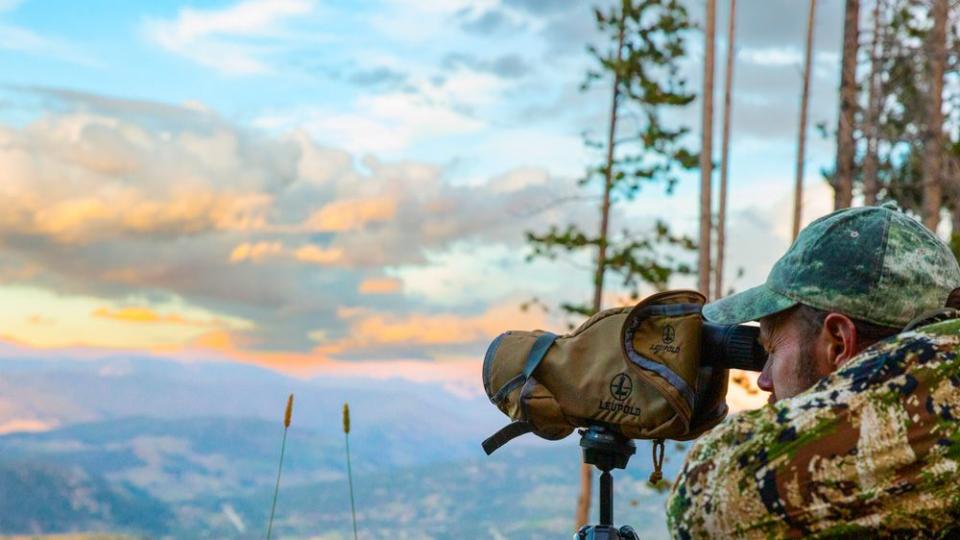
You Might Also Like

